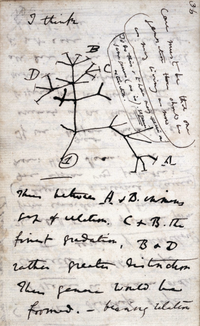
Photo from wikipedia
Lung adenocarcinoma (ADC) is the most prevalent subtype of lung cancer and characterized by considerable morphological and mutational heterogeneity. However, little is known about the epigenomic intratumor variability between spatially… Click to show full abstract
Lung adenocarcinoma (ADC) is the most prevalent subtype of lung cancer and characterized by considerable morphological and mutational heterogeneity. However, little is known about the epigenomic intratumor variability between spatially separated histological growth patterns of ADC. In order to reconstruct the clonal evolution of histomorphological patterns, we performed global DNA methylation profiling of 27 primary tumor regions, seven matched normal tissues and six lymph node metastases from seven ADC cases. Additionally, we investigated the methylation data from 369 samples of the TCGA ADC cohort. All regions showed varying degrees of methylation changes between segments of different, but also of the same growth patterns. Similarly, copy number variations were seen between spatially distinct segments of each patient. Hierarchical clustering of promoter methylation revealed extensive heterogeneity within and between the cases. Intratumor DNA methylation heterogeneity demonstrated a branched clonal evolution of ADC regions driven by genomic instability with subclonal copy number changes. Notably, methylation profiles within tumors were not more similar to each other than to those from other individuals. In two cases, different tumor regions of the same individuals were represented in distant clusters of the TCGA cohort, illustrating the extensive epigenomic intratumor heterogeneity of ADCs. We found no evidence for the lymph node metastases to be derived from a common growth pattern. Instead, they had evolved early and separately from a particular pattern in each primary tumor. Our results suggest that extensive variation of epigenomic features contributes to the molecular and phenotypic heterogeneity of primary ADCs and lymph node metastases.
Journal Title: International Journal of Cancer
Year Published: 2019
Link to full text (if available)
Share on Social Media: Sign Up to like & get
recommendations!